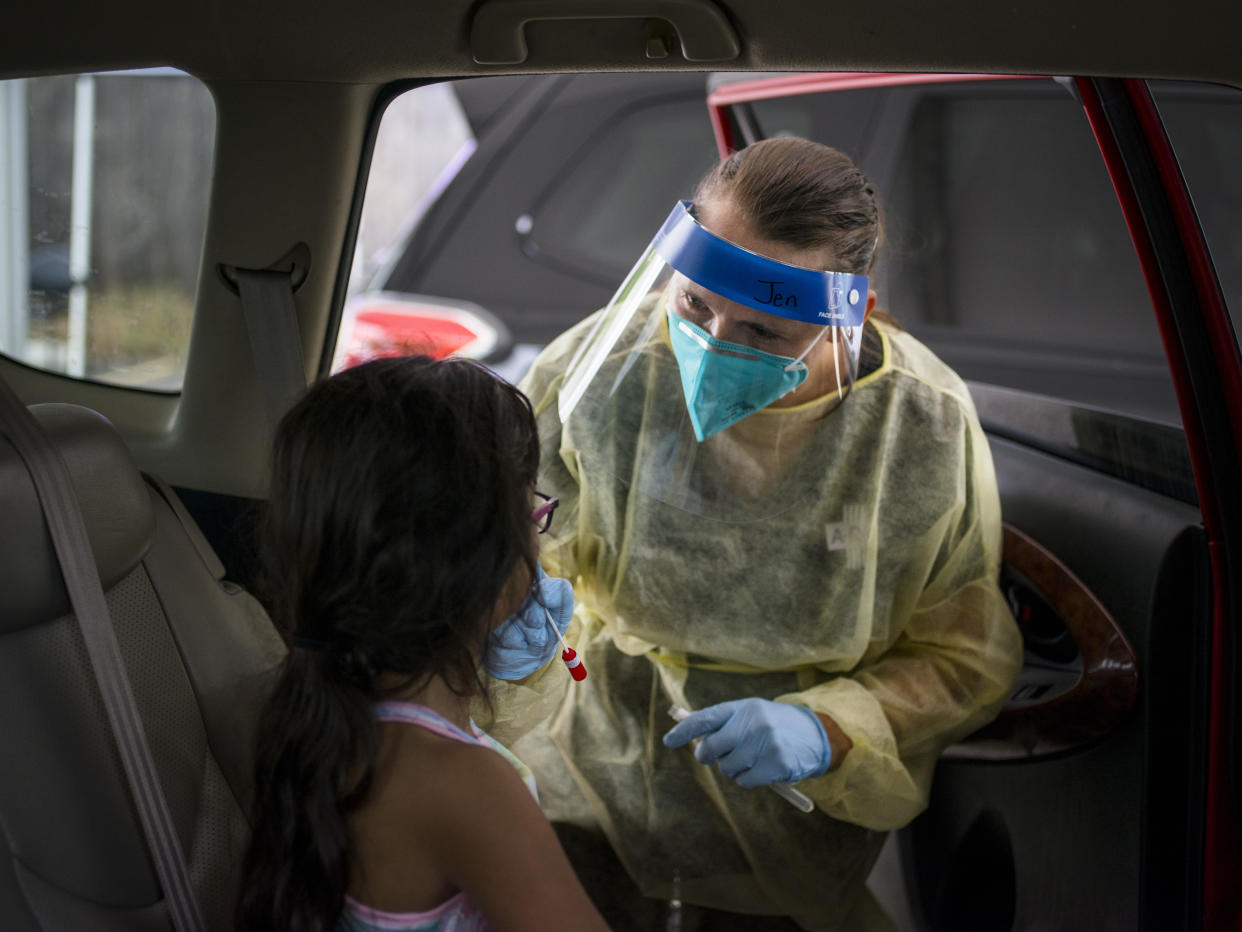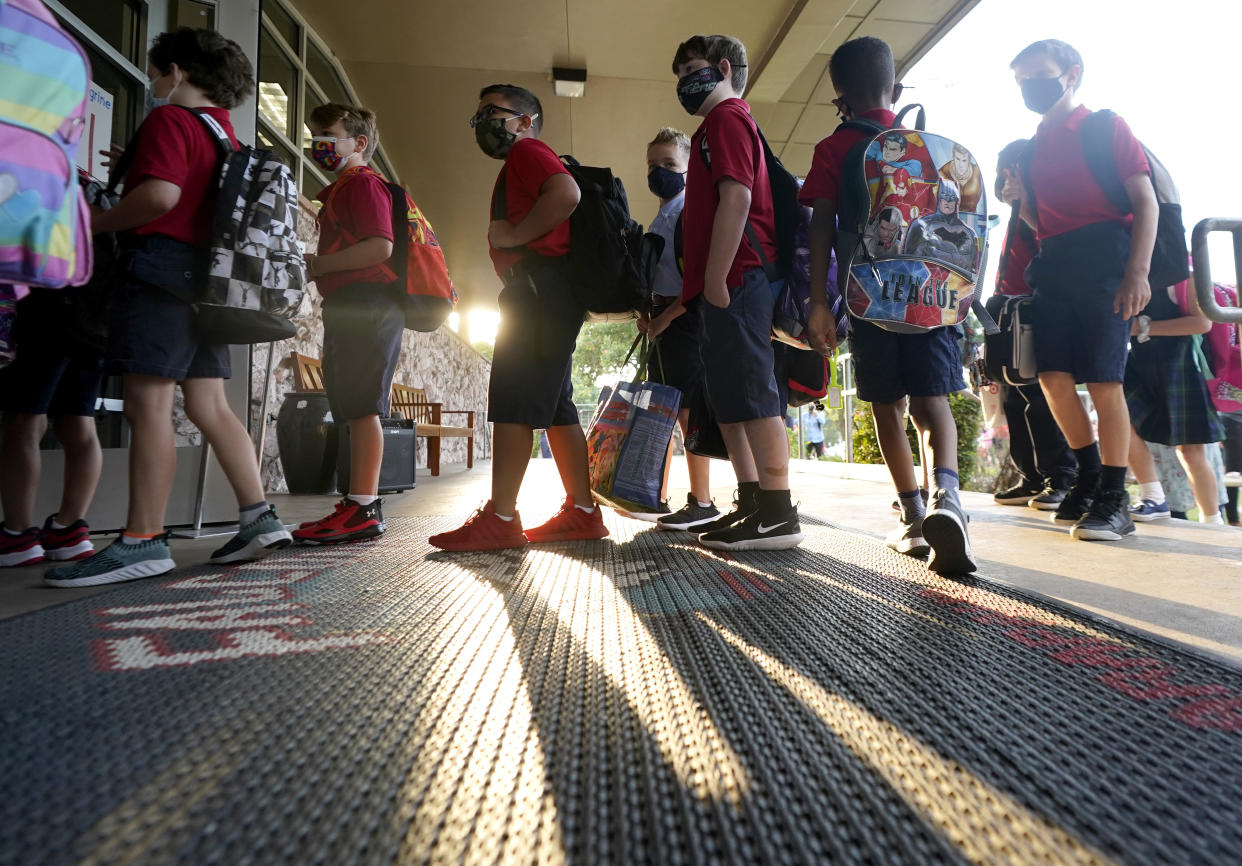Tens of thousands of students have already been forced into COVID quarantine. Mask bans are making it worse.
It’s the time of year when parents are supposed to be sending their kids back to school. Instead, the hypercontagious Delta variant is sending tens of thousands of them right back home.
In school districts across the United States, students and staff have been showing up for the first day of instruction only to discover — almost immediately — that they now have to isolate or quarantine for a week or more after testing positive themselves or coming into close contact with someone who has.
That’s been especially true in COVID-19 hot spots such as Florida, Texas and Tennessee, where Republican governors have prohibited schools from requiring masks in classrooms, despite sky-high local infection rates.
“A few months ago, it seemed it would be easy to keep the schools open this fall. Delta changed that,” Carl Bergstrom, an evolutionary biologist at the University of Washington and the co-creator of a new modeling tool for school outbreaks, explained Tuesday on Twitter. “I now worry that without aggressive mitigations, large outbreaks will sweep through school systems and require closures. We can’t afford that. Kids need to be back in school.”

The problem is so pervasive, it’s impossible to keep track of every new story and statistic.
After just five days of class, for example, about 8,400 students and 307 employees in one school district in the Tampa area — one of the largest in the U.S. — have already been forced to quarantine. A total of 467 new COVID cases were reported in the district on Monday alone, and the number of quarantining students jumped by nearly 3,000 the following day.
In Palm Beach County, Fla., it took just two days for school officials to send 440 students home.
At least four school districts in Georgia have shut down entirely after dozens of their students tested positive.
More than 700 students and staffers are currently quarantining in Warren County, Ky.; more than 4,400 are doing the same across Mississippi, where at least 1,000 students and school employees have tested positive.
Three rural Texas school districts have closed their doors for at least a week because of COVID-19 outbreaks — one because it was “unable to properly staff its campus” with so many “COVID-positive staff members.”

According to the Scottsdale, Ariz., superintendent — whose team has already confirmed more than 100 cases and sent nearly 800 students home from five of its 22 campuses — his schools might soon have to “return to virtual learning.”
And more than 1,000 students and staff in Nashville, at least twice that many in Deer Valley, Ariz., and the entire fourth-grade class at Patrick Henry School of Science and Arts in Richmond, Va., are all unable to attend school at present due to exposure.
Children, it seems, stand a much lower chance of getting seriously ill or dying from COVID than adults. But the more COVID they’re exposed to, the more of them will get sick or die, or suffer long-term complications. In turn, the unfettered spread of Delta — which can be transmitted by vaccinated people and in most parts of the U.S. no longer has to contend with the kind of precautionary measures that slowed down earlier, far less contagious variants — has exposed more kids to the virus than ever before.
If Florida, Louisiana and Mississippi were countries, they would currently rank Nos. 1, 3 and 4, respectively, for the most confirmed COVID cases per capita in the world; all three, plus Arkansas, Hawaii, Oregon and Washington, are now recording more daily hospitalizations than they have at any time during the pandemic. As a result, the number of children hospitalized with COVID-19 in the U.S. hit a record high of just over 1,900 on Saturday, according to Reuters. Not a single one of them under 12 is yet eligible to be vaccinated.
Even if you set aside the health risks for unvaccinated school kids, as many Americans seem to want to do, it’s difficult to ignore the educational and economic consequences. Constantly having to leave school to quarantine for one or two weeks is bad for kids who are trying to learn. It’s bad for parents who were relying on their kids being at school in order to work. And it’s bad for businesses that were counting on those parents to do their jobs instead of juggling childcare.

“Employers have put a lot of effort into encouraging their workforce to get vaccinated, and that’s the right thing to do,” Dr. Caitlin Rivers, an infectious disease epidemiologist at the Johns Hopkins Center for Health Security, recently told Yahoo News.
“But if kids are constantly having to quarantine for a week or more, and someone’s got to stay home with them, it’s not the case that having a highly vaccinated workforce will take that problem off the table,” she said. “For people who can work at home, for instance, it’s very difficult to work at home with children there. And then, of course, there are a lot of jobs where it might not be possible to work from home. Those families may face lost wages or endangered employment. And so there can be serious consequences of not minimizing the need to quarantine by minimizing the spread of COVID in schools.”
Seen in that light, the push to ban local leaders from requiring masks in classrooms seems even more self-defeating than it did at first glance. Not only are GOP governors such as Ron DeSantis of Florida, Greg Abbott of Texas and Bill Lee of Tennessee prohibiting one of the most effective and efficient strategies for minimizing SARS-CoV-2 transmission. They’re also maximizing the odds that the very thing they say they want for families and business alike — a return to in-person school — gets interrupted as early and as often as possible.
Having now witnessed the havoc that school quarantines can wreak on a community, some red state school districts are starting to buck their governors and reverse course. In Tempe, Ariz., Superintendent Kevin J. Mendivil sent a letter to families Monday explaining that he will now be requiring masks indoors “as a result of the level of positive COVID cases we are seeing in our schools” (even though Arizona’s GOP Gov. Doug Ducey has also tried to ban such rules). On Wednesday, the Tampa-area school board will hold an emergency meeting to consider mitigation strategies “up to and including mandatory face coverings for all students and staff.”

“We’re at that place,” the board’s chair, Lynn Gray, told the Tampa Bay Times. “It’s unavoidable.”
In Arkansas, where Republican Gov. Asa Hutchinson signed a bill preventing school districts from mandating masks — a decision he says he now regrets — Marion Superintendent Glen Fenter also put in place a belated mask requirement last week, after nearly 100 students tested positive for COVID-19 and 1,200 were sent home to quarantine.
“If we had masks on our students and our faculty from day one, instead of having 1,200 quarantines, we would have experienced roughly 100,” the superintendent told WREG.
Fenter’s math on masks raises an important point. Studies from the United Kingdom and elsewhere show that with proper mitigation measures — good ventilation, universal masking, frequent testing and so on — there actually tends to be less transmission among kids in schools than among kids in the surrounding community, even during a Delta surge. Mostly, it appears that kids get the virus outside school — especially at home or while participating in “inconsistently masked” activities like sports — and only then bring it into the classroom. The reverse is less common.
That’s why experts say the best way to keep younger kids safe and schools open is for everyone around them — parents, siblings, teachers, staff and older students — to get vaccinated. The lower the infection rate in the surrounding community, the fewer cases will crop up in classrooms.

But it’s also why experts are urging everyone to mask up on campus as well. Last school year, the Centers for Disease Control and Prevention recommended an extended quarantine period of up to 14 days for any unvaccinated person who experienced a “close contact” (i.e., “more than 15 minutes over a 24-hour period within 0-6 feet indoors”) with someone who tests positive. But the CDC’s K-12 guidance has evolved with the science, and now the agency allows for a modified quarantine if “both the infected student and the exposed student(s) correctly and consistently wore well-fitting masks the entire time.”
What’s a modified quarantine? According to a California Department of Public Health summary of the updated CDC guidance, exposed students “may continue to attend school for in-person instruction” as long as “they are asymptomatic; continue to appropriately mask, as required; undergo at least twice weekly testing during the 10-day quarantine; and continue to quarantine for all extracurricular activities at school, including sports, and activities within the community setting.”
In short, if everyone is wearing a mask, only students who test positive automatically have to miss class. Hence the Arkansas superintendent’s remark about 100 quarantines instead of 1,200 — a significantly smaller disruption.

Some areas — like Los Angeles, which requires 10 days of quarantine for all unvaccinated close contacts and eight days for all vaccinated close contacts — go further than the CDC says is strictly necessary, which means a lower bar for disruptions. (Los Angeles is also testing all 500,000 of its students and staff weekly, so positives will turn up.) Other states such as Arizona (where Gov. Ducey is telling districts it’s illegal to quarantine unvaccinated students who were exposed to COVID) and Texas (where Gov. Abbott does not require schools to conduct contact tracing) are gambling on a far riskier approach than the CDC recommends.
But either way, universal indoor masking is key.
To stay open during a Delta surge, Bergstrom’s model shows schools also need social distancing, improved ventilation, frequent testing and for as many eligible students, staff and family members to get vaccinated as possible.
“I still think that communities committed to keeping their schools open should be able to do so safely,” Bergstrom explained on Twitter. “But it won’t be a cakewalk. It will take concerted action: a combination of vaccination, testing, and other NPIs [nonpharmaceutical interventions], along with efforts to keep community prevalence low.”
Masking is just the first — and the easiest — part of this multipronged approach. Unfortunately, only half of America’s 100 largest school districts required masks as of last Thursday, and the rate in smaller districts is likely to be even lower.
“Our kids belong in school,” Florida’s DeSantis tweeted in February, and parents and employers agree. But bans on universal masking are now making it harder to keep them there.
____
Read more from Yahoo News:



